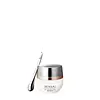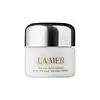What's inside
What's inside
 Key Ingredients
Key Ingredients

 Benefits
Benefits

 Concerns
Concerns

 Ingredients Side-by-side
Ingredients Side-by-side

Water
Skin ConditioningHydrogenated Polydecene
EmollientGlycerin
HumectantMaltitol
HumectantTriethylhexanoin
MaskingDipropylene Glycol
HumectantBehenyl Alcohol
EmollientCera Alba
EmollientGlyceryl Stearate
EmollientHydrogenated Castor Oil Hydroxystearate
Skin ConditioningCera Microcristallina
Emulsion StabilisingCetyl Palmitate
EmollientCeteth-20
CleansingDimethicone
EmollientNiacinamide
SmoothingSodium Stearoyl Glutamate
CleansingStearic Acid
CleansingButylene Glycol
HumectantDipotassium Glycyrrhizate
HumectantMethylserine
Skin ConditioningXanthan Gum
EmulsifyingAcetyl Glucosamine
Skin ConditioningAlcohol
AntimicrobialDisodium EDTA
Fucus Vesiculosus Extract
EmollientDimethoxy Di-P-Cresol
AntioxidantAlthaea Officinalis Root Extract
Skin ConditioningHydrolyzed Silk
HumectantZostera Marina Extract
Skin ConditioningPyracantha Fortuneana Fruit Extract
Skin ConditioningPoria Cocos Extract
Skin ConditioningHydrolyzed Conchiolin Protein
Skin ConditioningBHT
AntioxidantPhenoxyethanol
PreservativeSodium Benzoate
MaskingWater, Hydrogenated Polydecene, Glycerin, Maltitol, Triethylhexanoin, Dipropylene Glycol, Behenyl Alcohol, Cera Alba, Glyceryl Stearate, Hydrogenated Castor Oil Hydroxystearate, Cera Microcristallina, Cetyl Palmitate, Ceteth-20, Dimethicone, Niacinamide, Sodium Stearoyl Glutamate, Stearic Acid, Butylene Glycol, Dipotassium Glycyrrhizate, Methylserine, Xanthan Gum, Acetyl Glucosamine, Alcohol, Disodium EDTA, Fucus Vesiculosus Extract, Dimethoxy Di-P-Cresol, Althaea Officinalis Root Extract, Hydrolyzed Silk, Zostera Marina Extract, Pyracantha Fortuneana Fruit Extract, Poria Cocos Extract, Hydrolyzed Conchiolin Protein, BHT, Phenoxyethanol, Sodium Benzoate
Water
Skin ConditioningLaminaria Digitata Extract
Skin ProtectingButyrospermum Parkii Butter
Skin ConditioningButylene Glycol
HumectantPolyethylene
AbrasiveHydrogenated Polyisobutene
EmollientDimethicone
EmollientCetyl Esters
EmollientCetearyl Alcohol
EmollientMalachite
Skin ConditioningPolybutene
Isostearyl Neopentanoate
EmollientSilica
AbrasiveTrisiloxane
Skin ConditioningYeast Extract
Skin ConditioningCaffeine
Skin ConditioningCholesterol
EmollientAscophyllum Nodosum Extract
Skin ConditioningAsparagopsis Armata Extract
Skin ProtectingGelidium Cartilagineum Extract
Skin ProtectingSaccharomyces Lysate Extract
HumectantSesamum Indicum Seed Oil
EmollientEucalyptus Globulus Leaf Oil
PerfumingSesamum Indicum Seed
AbrasiveMedicago Sativa Seed Powder
Skin ConditioningHelianthus Annuus Seedcake
AbrasivePrunus Amygdalus Dulcis Seed Meal
AbrasiveSodium Gluconate
Skin ConditioningPotassium Gluconate
Skin ProtectingCopper Gluconate
Skin ConditioningCalcium Gluconate
HumectantMagnesium Gluconate
Skin ConditioningZinc Gluconate
Skin ConditioningTocopheryl Succinate
AntioxidantNiacin
SmoothingSigesbeckia Orientalis Extract
Skin ConditioningLactis Proteinum
Skin ConditioningSucrose
HumectantElaeis Guineensis Oil
EmollientMethyl Glucose Sesquistearate
EmollientCetearyl Glucoside
EmulsifyingGlycerin
HumectantAminomethyl Propanol
BufferingGlyceryl Distearate
EmollientTetraacetylphytosphingosine
Skin ConditioningLinoleic Acid
CleansingSorbitol
HumectantAcrylates/C10-30 Alkyl Acrylate Crosspolymer
Emulsion StabilisingSteareth-10
EmulsifyingMagnesium Ascorbyl Phosphate
AntioxidantVinyl Dimethicone/Methicone Silsesquioxane Crosspolymer
Sodium Hyaluronate
HumectantTocotrienols
Skin ConditioningHexylene Glycol
EmulsifyingPhytosphingosine
Skin ConditioningIsododecane
EmollientTocopherol
AntioxidantSqualene
EmollientPropylene Glycol Diheptanoate
EmollientPhytosterols
Skin ConditioningTrimethylsiloxysilicate
EmollientCaprylyl Glycol
EmollientAcetyl Hexapeptide-8
HumectantCarbomer
Emulsion StabilisingParfum
MaskingTourmaline
Disodium EDTA
Sodium Dehydroacetate
PreservativePhenoxyethanol
PreservativeLinalool
PerfumingLimonene
PerfumingBenzyl Salicylate
PerfumingCI 42090
Cosmetic ColorantCI 19140
Cosmetic ColorantCI 77891
Cosmetic ColorantCI 61570
Cosmetic ColorantWater, Laminaria Digitata Extract, Butyrospermum Parkii Butter, Butylene Glycol, Polyethylene, Hydrogenated Polyisobutene, Dimethicone, Cetyl Esters, Cetearyl Alcohol, Malachite, Polybutene, Isostearyl Neopentanoate, Silica, Trisiloxane, Yeast Extract, Caffeine, Cholesterol, Ascophyllum Nodosum Extract, Asparagopsis Armata Extract, Gelidium Cartilagineum Extract, Saccharomyces Lysate Extract, Sesamum Indicum Seed Oil, Eucalyptus Globulus Leaf Oil, Sesamum Indicum Seed, Medicago Sativa Seed Powder, Helianthus Annuus Seedcake, Prunus Amygdalus Dulcis Seed Meal, Sodium Gluconate, Potassium Gluconate, Copper Gluconate, Calcium Gluconate, Magnesium Gluconate, Zinc Gluconate, Tocopheryl Succinate, Niacin, Sigesbeckia Orientalis Extract, Lactis Proteinum, Sucrose, Elaeis Guineensis Oil, Methyl Glucose Sesquistearate, Cetearyl Glucoside, Glycerin, Aminomethyl Propanol, Glyceryl Distearate, Tetraacetylphytosphingosine, Linoleic Acid, Sorbitol, Acrylates/C10-30 Alkyl Acrylate Crosspolymer, Steareth-10, Magnesium Ascorbyl Phosphate, Vinyl Dimethicone/Methicone Silsesquioxane Crosspolymer, Sodium Hyaluronate, Tocotrienols, Hexylene Glycol, Phytosphingosine, Isododecane, Tocopherol, Squalene, Propylene Glycol Diheptanoate, Phytosterols, Trimethylsiloxysilicate, Caprylyl Glycol, Acetyl Hexapeptide-8, Carbomer, Parfum, Tourmaline, Disodium EDTA, Sodium Dehydroacetate, Phenoxyethanol, Linalool, Limonene, Benzyl Salicylate, CI 42090, CI 19140, CI 77891, CI 61570
Ingredients Explained
These ingredients are found in both products.
Ingredients higher up in an ingredient list are typically present in a larger amount.
Butylene Glycol (or BG) is used within cosmetic products for a few different reasons:
Overall, Butylene Glycol is a safe and well-rounded ingredient that works well with other ingredients.
Though this ingredient works well with most skin types, some people with sensitive skin may experience a reaction such as allergic rashes, closed comedones, or itchiness.
Learn more about Butylene GlycolDimethicone is a type of synthetic silicone created from natural materials such as quartz.
What it does:
Dimethicone comes in different viscosities:
Depending on the viscosity, dimethicone has different properties.
Ingredients lists don't always show which type is used, so we recommend reaching out to the brand if you have questions about the viscosity.
This ingredient is unlikely to cause irritation because it does not get absorbed into skin. However, people with silicone allergies should be careful about using this ingredient.
Note: Dimethicone may contribute to pilling. This is because it is not oil or water soluble, so pilling may occur when layered with products. When mixed with heavy oils in a formula, the outcome is also quite greasy.
Learn more about DimethiconeDisodium EDTA plays a role in making products more stable by aiding other preservatives.
It is a chelating agent, meaning it neutralizes metal ions that may be found in a product.
Disodium EDTA is a salt of edetic acid and is found to be safe in cosmetic ingredients.
Learn more about Disodium EDTAGlycerin is already naturally found in your skin. It helps moisturize and protect your skin.
A study from 2016 found glycerin to be more effective as a humectant than AHAs and hyaluronic acid.
As a humectant, it helps the skin stay hydrated by pulling moisture to your skin. The low molecular weight of glycerin allows it to pull moisture into the deeper layers of your skin.
Hydrated skin improves your skin barrier; Your skin barrier helps protect against irritants and bacteria.
Glycerin has also been found to have antimicrobial and antiviral properties. Due to these properties, glycerin is often used in wound and burn treatments.
In cosmetics, glycerin is usually derived from plants such as soybean or palm. However, it can also be sourced from animals, such as tallow or animal fat.
This ingredient is organic, colorless, odorless, and non-toxic.
Glycerin is the name for this ingredient in American English. British English uses Glycerol/Glycerine.
Learn more about GlycerinPhenoxyethanol is a preservative that has germicide, antimicrobial, and aromatic properties. Studies show that phenoxyethanol can prevent microbial growth. By itself, it has a scent that is similar to that of a rose.
It's often used in formulations along with Caprylyl Glycol to preserve the shelf life of products.
Water. It's the most common cosmetic ingredient of all. You'll usually see it at the top of ingredient lists, meaning that it makes up the largest part of the product.
So why is it so popular? Water most often acts as a solvent - this means that it helps dissolve other ingredients into the formulation.
You'll also recognize water as that liquid we all need to stay alive. If you see this, drink a glass of water. Stay hydrated!
Learn more about Water